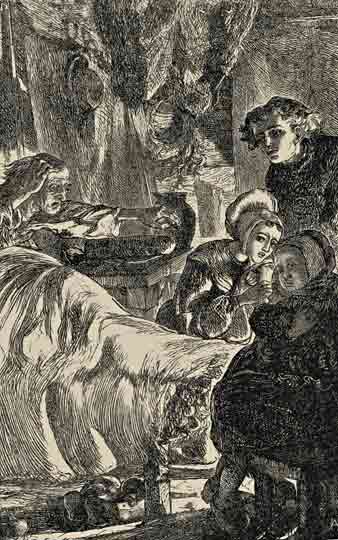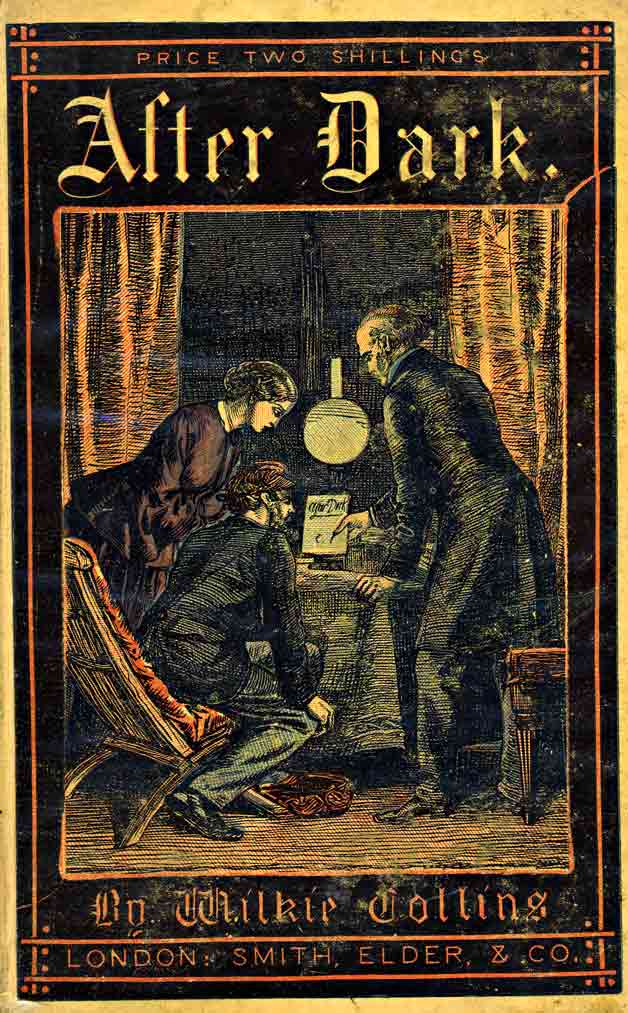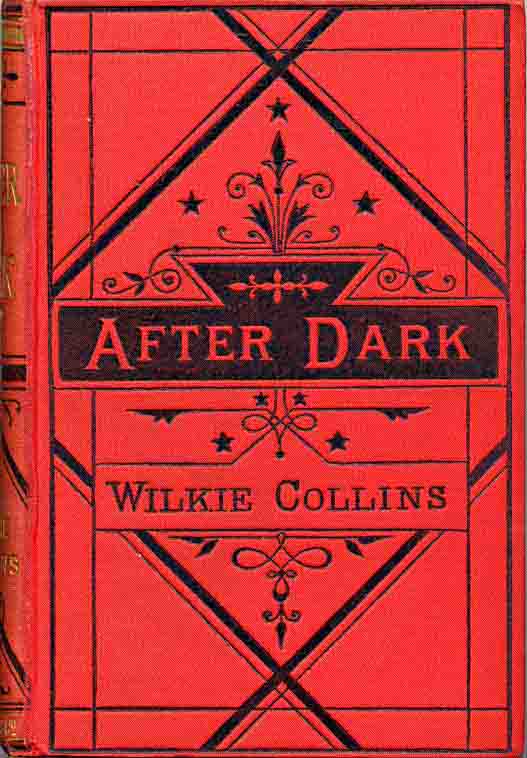AFTER DARK
[ Front Page ] [ Publishing History ]
[ Terribly Strange Bed ] [ Stolen Letter ] [ Sister Rose ]
[ Lady of Glenwith Grange ] [ Gabriel's Marriage ] [ Yellow Mask ]
|
|
|
1876 Yellowback edition of After Dark |
After Dark is Wilkie Collins's first collection of six short stories, published in 1856. Collins provides a narrative framework, 'Leaves from Leah's Diary', set in 1827. Leah Kerby's husband, William, is a poor travelling portrait-painter forced to abandon his profession for six months in order to save his sight. Leah realises that if she acts as amanuensis William can support them by turning author. This situation may have been prompted by a period of eye-trouble suffered by Collins's father. In the preface to After Dark, Collins also acknowledges the painter W. S. Herrick as his source for the facts on which 'A Terribly Strange Bed' and 'The Yellow Mask' are based.
'The
Traveller's Story of A Terribly Strange Bed' was originally published on 24 April 1852 as
Collins's first contribution to Household Words.
Faulkner, the narrator,
tells how as a young man he visited a low class gambling house in Paris. After breaking the bank, he accepts accommodation rather than
risk taking his large winnings home late at night. The canopy of the four poster bed is attached to a screw by
which it can be lowered from the room above to suffocate unsuspecting victims.
Unable to sleep, Faulkner discovers the danger, escaping to return with
the police.
The
same plot was used in Uncle
Z
by Greville Phillimore (1881):
and for 'The Inn of the Two Witches' (1913), a tale by Joseph Conrad
who claimed never to have read Collins's story.
'The Lawyer's
Story of A Stolen Letter' is an
early detective story, probably influenced by Edgar Allan Poe's 'The Purloined
Letter'. It
was originally published with the title 'The Fourth Poor Traveller' in
'The Seven Poor Travellers', the Extra Christmas Number of Household Words
for December 1854.
The narrator is a lawyer who contrives, in a series of ingenious moves, to steal back an incriminating letter from a blackmailer. The letter contains a confession to an attempted forgery by the dead father of a poor young governess, Miss Smith. The lawyer's success enables her marriage to a rich young man, Frank Gatliffe, to take place without the threat of scandal.
'The
French Governess's Story of Sister Rose'
is a long short story originally published in Household Words
7-28 April 1855. There
is an
added Prologue included in this version for After Dark.
The
first
separate publication was a pirated edition by Petersons of Philadelphia in 1855
where it was wrongly attributed to Dickens.
Set against the background of the French
Revolution, the story concerns Louis Trudaine; his sister, Rose, who contracts
an unhappy marriage to the aristocratic Charles Danville; and Danville's
land-steward, Lomaque, who is indebted to Trudaine's father.
Trudaine fulfils a deathbed promise to his mother to protect Rose and
arouses Danville's animosity. Danville
denounces Trudaine to the revolutionary authorities, implicating Rose.
Through his lies at their trial, both brother and sister are both
condemned to the guillotine. Lomaque,
who has become a police agent, saves their lives by removing their names from
the death list with a chemical formula. Freed
by the downfall of Robespierre, the brother and sister confront Danville three
years later as he is about to remarry. He is rejected by his mother and killed in a duel.
The Trudaines and Lomaque return to the tranquillity of the family home
in Rouen.
The story is a likely influence on A Tale of Two Cities (1859), set in revolutionary France and featuring an escape from prison through substitution.
'The Angler's Story of The Lady of Glenwith Grange' was published for the first time in After Dark.
Ida Welwyn promises her
dying mother that she will always look after her younger sister, Rosamond. Against Ida's better instincts, Rosamond marries Baron
Franval whom she meets in Paris. A
French police agent exposes the Baron as an impostor called Monbrun and he is
killed while trying to escape. Rosamond
dies of shock leaving her retarded daughter to be brought up by the reclusive
Ida at Glenwith Grange.
'The
Nun's Story of Gabriel's Marriage'
was originally published in Household Words,
16-23 April 1853. The plot was
rewritten as the basis for the play The Lighthouse
in 1855.
The scene is Brittany at the time of the French
Revolution. Gabriel Sarzeau
becomes estranged from his fisherman father when he discovers that he
committed a murder. Before his
marriage, Gabriel confesses his knowledge to Father Paul, a fugitive priest.
Father Paul reveals that he was the victim but survived his wounds.
He performs the marriage ceremony, forgives his attacker, and
reconciles father and son.
 |
|
Illustration of 'Gabriels Marriage' from the Chatto & Windus edition |
'The
Professor's Story of The Yellow Mask'
was originally published in Household Words,
7-28 July 1855. The story uses
the idea of making a mask from the cast of a statue, first employed in Mr
Wray's Cash-Box (1852). A
second theme, of recovering money for the Church, reappears in The Black
Robe (1881).
Count Fabio d'Ascoli is a pupil of the
master-sculptor, Luca Lomi. Lomi's
brother, Father Rocco of Pisa, believes that part of the young Count's
inheritance is money stolen from the Church.
In order to recover it, Rocco plans to have Fabio marry Lomi's
daughter, Maddalena, over whom he can exert influence.
He persuades Fabio's true love, the naive model Nanina, to leave Pisa.
The marriage takes place but Maddalena dies the following year after
the birth of a daughter. Rocco
decides to play on Fabio's superstitions to prevent him from remarrying.
He employs the mercenary Brigida to impersonate Maddalena at a masked
ball by wearing a yellow mask over a cast of Maddalena's face.
Fabio is so shocked at the ghost of his dead wife that his mind is
temporarily unhinged. Nanina is
able to prove that he has been tricked by natural means and they are happily
married.
PUBLISHING
HISTORY FOR AFTER DARK
|
|
|
1888 Smith Elder edition |
Serialisation
For first publication see individual stories above.
Book
publication
First edition
2 volumes, Smith,
Elder, London 1856. Dark grey-green
cloth, covers blocked in blind, spines lettered in gilt, pale yellow end-papers.
Half-title in each volume. Published
in February 1856. Variant binding
in paper boards, half cloth, with white end-papers.
Vol I
viii + 316 pp. 16 pp publishers' catalogue bound in
at end (dated January, February or April 1856).
Vol II
(iv) + 324 pp. Publisher's
advertisement occupies p. (323).
1 volume
editions
Smith, Elder
1859-1890 (with 5 Illustrations by [A. B. Houghton]); Chatto & Windus
1890-1925.
First US
edition
Dick &
Fitzgerald, New York [1856].
Translations
German, Lemgo 1859; Polish, Lwow 1871; Dutch, The Hague 1876.
[Top
of Page] [Main Works] [

